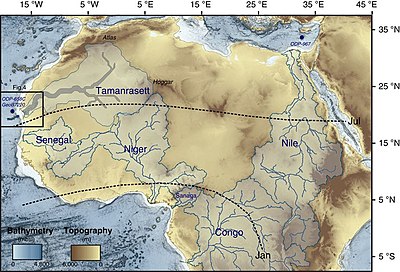| This is a draft article. It is a work in progress open to editing by anyone. Please ensure core content policies are met before publishing it as a live Wikipedia article. Find sources: Google (books · news · scholar · free images · WP refs) · FENS · JSTOR · TWL Last edited by Anomalocaris (talk | contribs) 3 years ago. (Update) |

The Tamanrasset River is an enormous palaeoriver believed to have flew through West Africa as recently as 5000 years ago. The Tamanrasset River basin is thought to have been comparable with the present-day Ganges-Brahmaputra river basin in Asia.[2][3][4][5][6]
Overview
editThe Tamanrasett is thought to have flowed across the Sahara in ancient times from sources in the southern Atlas mountains and Hoggar highlands in what is now Algeria.[3]
It is thought the rive fed into the Cap Timiris Canyon, located off the coast of Mauritania, the canyon is located in waters three kilometres deep and is is 2.5 km wide in places.[7][3]
The presence of the river is thought to have wide ranging implications for human migration from Central Africa to the Middle East, Europe, and Asia. Perviously, the inhospitable Sahara desert was believed to have made a western route for migrating to Europe unviable.[8][9][10]
Researchers believe that the ancient Tamanrasett river has become active during African Humid Period, climate oscillations caused by the Earth's precessional orbit around the Sun.[4]
The palaeoriver was discovered using a Japanese orbital satellite system called Phased Array type L-band Synthetic Aperture Radar (PALSAR). Using microwave sensing, PALSAR can see below Saharan sands and detect the fossil water still flowing.[5]
See also
editReferences
edit- ^ Skonieczny, C.; Paillou, P.; Bory, A.; Bayon, G.; Biscara, L.; Crosta, X.; Eynaud, F.; Malaizé, B.; Revel, M.; Aleman, N.; Barusseau, J. -P.; Vernet, R.; Lopez, S.; Grousset, F. (2015). "African humid periods triggered the reactivation of a large river system in Western Sahara". Nature Communications. 6 (1). Bibcode:2015NatCo...6E8751S. doi:10.1038/ncomms9751. ISSN 2041-1723.
- ^ Klokočník, Jaroslav; Kostelecký, Jan; Cílek, Václav; Bezděk, Aleš; Pešek, Ivan (2017). "A support for the existence of paleolakes and paleorivers buried under Saharan sand by means of "gravitational signal" from EIGEN 6C4" (PDF). Arabian Journal of Geosciences. 10 (9). doi:10.1007/s12517-017-2962-8. ISSN 1866-7511.
- ^ a b c Sample, I. (10 November 2015). "Ancient river network discovered buried under Saharan sand". The Guardian. Archived from the original on 13 November 2015.
- ^ a b Stone, M. (11 November 2015). "A Vast River Network Once Crisscrossed the Sahara". Gizmodo. Archived from the original on 11 November 2015.
- ^ a b Ferreira, B. (10 November 2015). "There's a Long-Lost 'Paleo-River' Beneath the Sahara Desert Nobody Knew Existed". motherboard.vice.com. Vice Media. Archived from the original on 7 November 2018.
- ^ Johnson, S. K. (10 November 2015). "Beneath the Saharan sands, a river valley". arstechnica.com. Condé Nast. Archived from the original on 11 November 2015.
- ^ Krastel, S.; Hanebuth, T. J. J.; Antobreh, A. A.; Henrich, R.; Holz, C.; Kölling, M.; Schulz, H. D.; Wien, K.; Wynn, R. B. (2004). "CapTimiris Canyon: A newly discovered channel system offshore of Mauritania". Eos, Transactions American Geophysical Union. 85 (42): 417. doi:10.1029/2004EO420001. ISSN 0096-3941.
- ^ Hart, John P.; Coulthard, Tom J.; Ramirez, Jorge A.; Barton, Nick; Rogerson, Mike; Brücher, Tim (2013). "Were Rivers Flowing across the Sahara During the Last Interglacial? Implications for Human Migration through Africa" (PDF). PLoS ONE. 8 (9): e74834. doi:10.1371/journal.pone.0074834. ISSN 1932-6203.
{{cite journal}}: CS1 maint: unflagged free DOI (link) - ^ Botkin-Kowacki, E. (12 November 2015). "Rivers may have once criss-crossed the Sahara, say scientists". The Christian Science Monitor. Archived from the original on 7 November 2018.
- ^ Lahr, M. M. (2010). "Saharan Corridors and Their Role in the Evolutionary Geography". In Fleagle, J. G.; Shea, J. J.; Grine, F. E.; Baden, A. L.; Leakey, R. E. (eds.). Out of Africa: The First Hominin Colonization of Eurasia (PDF). Dordrecht: Springer. ISBN 978-90-481-9035-5. LCCN 2010932000. OCLC 939066131. Archived from the original (PDF) on 29 March 2016.